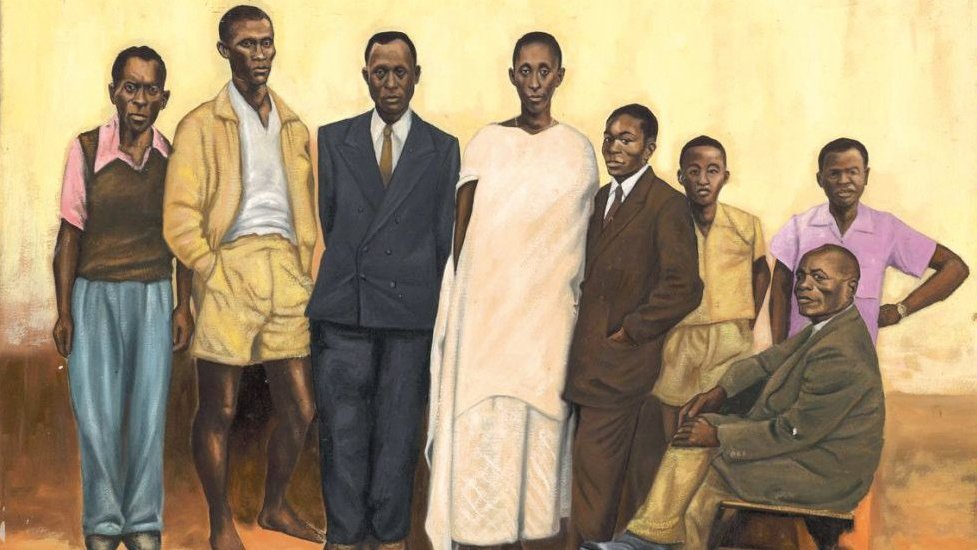Paint your history

The display's title itself holds a clue that suggests we shouldn't apply to Congolese art any of the usual stereotypes that portray it as ethnological rarities at best. The kind of art we typically view in museums and think of as treasures from the "other world". Instead, we should see it through the Congolese people's own eyes.
Controlled cognition
The exhibition sparks a broad debate on our clichéd and limiting habitual ways of looking at things that are culturally remote if not downright alien to us. You'd expect that documentaries and other television shows and widespread access to novel technologies would have made even the most distant regions of the globe much more familiar. Actually, on the contrary, they often perpetuate certain perceptions and opinions. As we regard strangers, we take on the role of viewers who only notice no more than mere snippets of the worlds of the people living in places far removed from ours, not only because of the distance, but also because of striking cultural differences.
We are well aware of stereotypes, some of them very hurtful, about every nation, race and nationality. We expect others to form opinions about us on the basis of actual interactions with ourselves. However, when we become observers, we find it difficult to break down the barriers that have long been rising and are largely passed down through generations. Therefore, despite access to information and means of long-distance travel, we do not know these "other" people who live in a different environment and are shaped by unlike circumstances. The context of events, and the environmental and historical factors that fashion their identities are a mystery to us. We settle for the knowledge we derive from one or other account or reportage, many of which fail to make the distant any closer.
From home to gallery
Congolese painting, which by virtue of appearing in world galleries and museums, has appreciated in value on the international art scene, has always been more than a mere ordinary home decoration for the Congolese themselves. Made commonly of old scraps of material, painted over with paints made by the artists themselves, the compositions once formed a key part of Congolese identity and a bond that kept society together.
"The paintings played a unique role in the living room, stimulating conversation on societal change. Relatively inexpensive, they became symbols of the past meeting the present in a given space. In an interview for the kultaliberalna.pl website, prof. Bogumił Jewsiewicki, curator of the exhibition prepared at the Castle (Zamek) Cultural Centre as well as a recognized Africanist, ethnologist, historian and collector of Congolese art, explained that, right next to music, popular paintings in Congo made up the national culture, acquiring great significance with the local communities". To him, this bears testimony to the memory and changes that took place in Congo throughout the 20th century and that are still ongoing.
The first chance to present Congolese paintings outside of Congo came with the exhibition "Magiciens de la terre" in Centre Pompidou in 1989, featuring works by artists from all over the world, including countries less known for their modern art. The latter included painters from Congo. However, a real breakthrough for this art was yet to come. Especially at the time international viewers saw the paintings in Centre Pompidou, the Congolese, including many local artists from Congo, had no idea that the exhibition was taking place or only had vague information about it. The news that one of the most famous Congolese artists, Chéri Samba, had gained the acclaim of world critics and audiences, hardly spread to his native country.
A perpetual sense of duty
It was not until two decades after the exhibition that people became truly aware of the phenomenon of Congo painting. This realisation only came at a time when life in Congo changed so much that art itself fell on hard times. The memory of the past began to blur as society underwent inevitable transformations. Artists, as they always have, guarded the values embodied in painting, creating images that continued to tell the story of the social and political changes unfolding in their country. However, the outcomes of their work have become and still are much less accessible.
"Popular painters considered themselves the chroniclers of everyday life. They used their paintings to record memories, looking at both the present and the past from the point of view of a person standing in a crowd, giving artistic expression to the voices of ordinary people", recalled prof. Jewsiewicki, pointing out that contemporary artists too share a great sense of responsibility for society and the world, and simply want to make a difference through their art. They take action against all odds and despite the possibility that the impact of what they are doing may be diminished.
Justyna Żarczyńska
translation: Krzysztof Kotkowski
- The Congolese Self-Portrait. Congo paintings from 1960-1990
- CK Zamek (ZAMEK Culture Centre)
- open until 19.12.
- tickets: 10-15 pln
© Wydawnictwo Miejskie Posnania 2021
See more

Waltzes, jazz songs and carols

From One Celebration to Another

Christmas Markets and Fairs with Attractions




